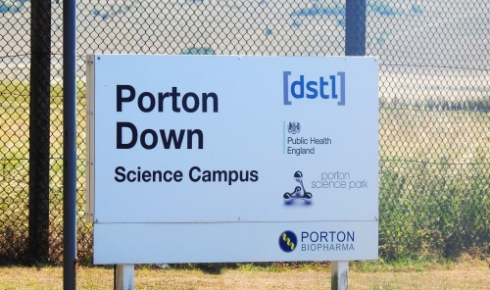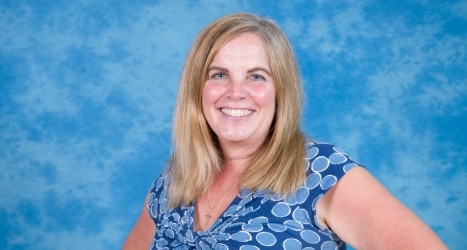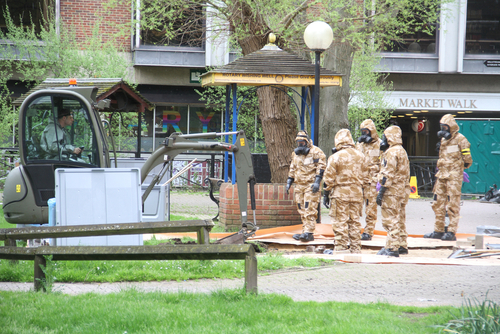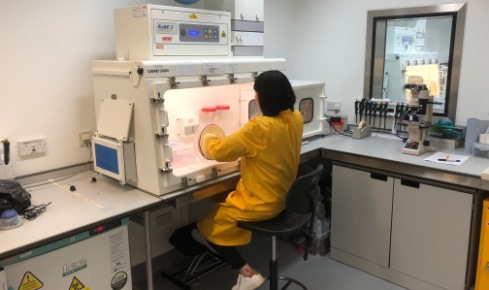My Lab Unlocked: Professor Petra Oyston at Porton Down

Professor Petra Oyston FRSB explains the unique projects and working life at the UK's Defence Science & Technology Laboratory (Dstl)
March 2021
I am exceptionally proud to work at Dstl. The Dstl site near Salisbury, known historically as Porton Down, has a history dating back to 1917, when it was set up in response to the use of gas in the trenches. The author Graydon Carter has written some fascinating books on the topic. The site was historically focused on chemical and biological defence research, but in later years has expanded to include a diverse range of defence research.
I work in the Chemical, Biological and Radiological (CBR) area of Dstl, which undertakes work to prevent, defend against and mitigate the effects of a chemical or biological attack. I have seen our staff respond to both national and international situations, from testing white powders in letters after the Anthrax Letter attacks, to screening people for Ebola during an outbreak in Africa, and of course, the Novichok poisonings in Salisbury.
Every time, the training and positivity of our staff shines through, despite challenging conditions and long days. So the thing I am proudest of is the combination values of scientific excellence and public service in our amazing staff.
 Professor Petra Oyston FRSB.
Professor Petra Oyston FRSB.My research at Dstl historically was mainly directed towards the development of vaccines and therapies for the prevention of serious bacterial infections that were of concern as potential bio-warfare agents. This has meant I have worked with some fascinating pathogens, such as the causative organism of plague, using genetic methods to understand the host-pathogen interaction, the regulation of genes important in that, and thus how we could stop the bacterium in its tracks by targeting those genes and proteins.
Subsequently, this led to an interest in how we could exploit biology to address some broader challenges in defence, and thus my interest in synthetic biology.
We started with a really big challenge, evaluating the ability of biology to support making armour materials. This has involved running external funding calls and overseeing a portfolio of innovative projects undertaken by UK industry and universities: it is a real privilege to work with our world-leading synthetic biology community.
For some projects, I have been able to supervise PhD students working in universities or at Dstl itself, which is really rewarding. I have also been able to represent the UK Government in various national and international forums, which adds a unique dimension to the work.
 Dstl staff at Porton Down helped identify the nerve agent used in the Salisbury poisoning in 2018.
Dstl staff at Porton Down helped identify the nerve agent used in the Salisbury poisoning in 2018. Like many emerging technologies, there are many ethical, regulatory and social issues surrounding synthetic biology. We need to ensure we bring the public along with us, or we will end up with resistance to the technology being used, as we did with genetically modified organisms some years ago. To do this we need to ensure the research we do is done responsibly, and the benefits articulated clearly, and to engage in an open dialogue of risks and benefits, and be aware of barriers to societal acceptance.
We have a unique microbiology containment building based at the Dstl site near Salisbury. Obviously, working with dangerous pathogens means we have specialised facilities so that we can work safely. As well as the specialised equipment, we also have very comprehensive training for working in those labs, and very thorough risk assessment. Working under these conditions is tiring for the staff, and slower than working at an open bench. It also means that sometimes there are techniques we would like to do, but if we cannot work out how to do it safely it will not happen, so you have to be quite pragmatic.
A lot of our work is carried out by researchers in academia and industry, and then translated into defence capability by Dstl staff. This means we get to work with the best on some really interesting challenges. So I am always interested in working with people doing innovative and ground-breaking work, but most especially I enjoy putting together multidisciplinary teams from diverse disciplines to do something really novel.
 A member of staff at work in the in the high containment microbiology laboratory at Dstl Porton Down. Picture courtesy of Dstl and Dr G. Choules.
A member of staff at work in the in the high containment microbiology laboratory at Dstl Porton Down. Picture courtesy of Dstl and Dr G. Choules.
In terms of the pandemic, there are two types of work going on: supporting the Covid effort and what we could call ‘business as usual’. A big challenge has been deciding what of the latter we needed to stop in order to deliver the former. A second challenge has been determining the impact of COVID and lockdowns on the delivery of work by our contractors.
Finally, there is the challenge of working from home, being interrupted by cats and children, learning how to use a variety of new conferencing platforms, trying to schedule in bathroom breaks between endless back-to-back calls and having rural broadband.
Professor Petra Oyston FRSB is Technical Fellow within the Chemical, Biological and Radiological Division of Dstl.
©Crown Copyright (2021), Dstl. This material is licensed under the terms of the Open Government Licence except where otherwise stated. To view this licence, visit http://www.nationalarchives.gov.uk/doc/open-government-licence/version/3, write to the Information Policy Team, The National Archives, Kew, London TW94DU, or email: psi@ nationalarchives.gsi.gov.uk.


